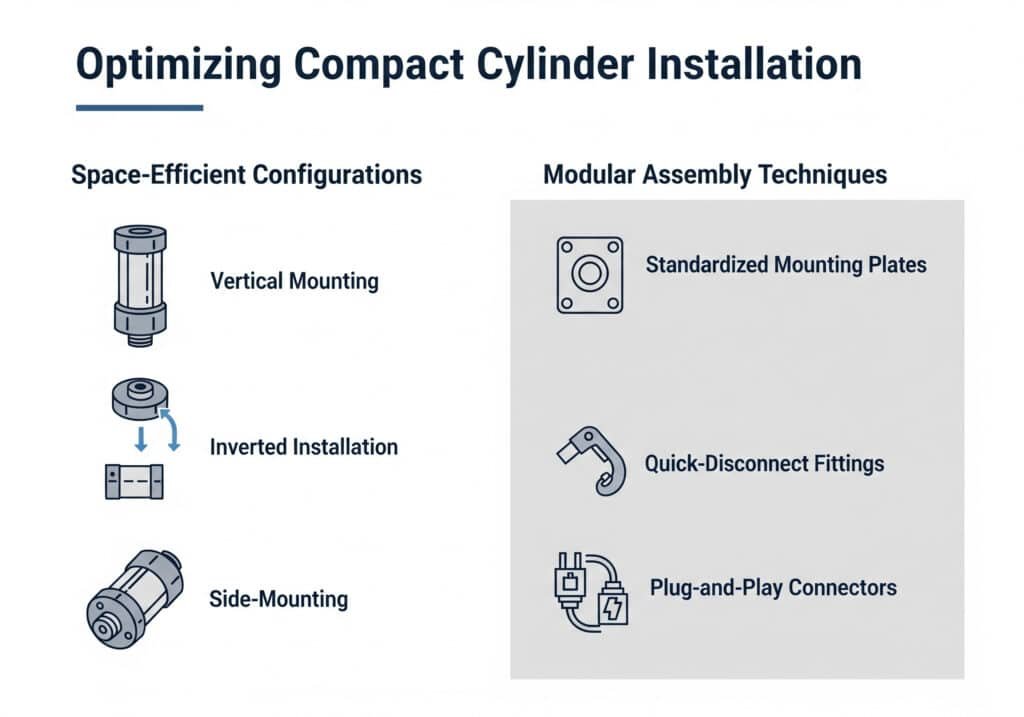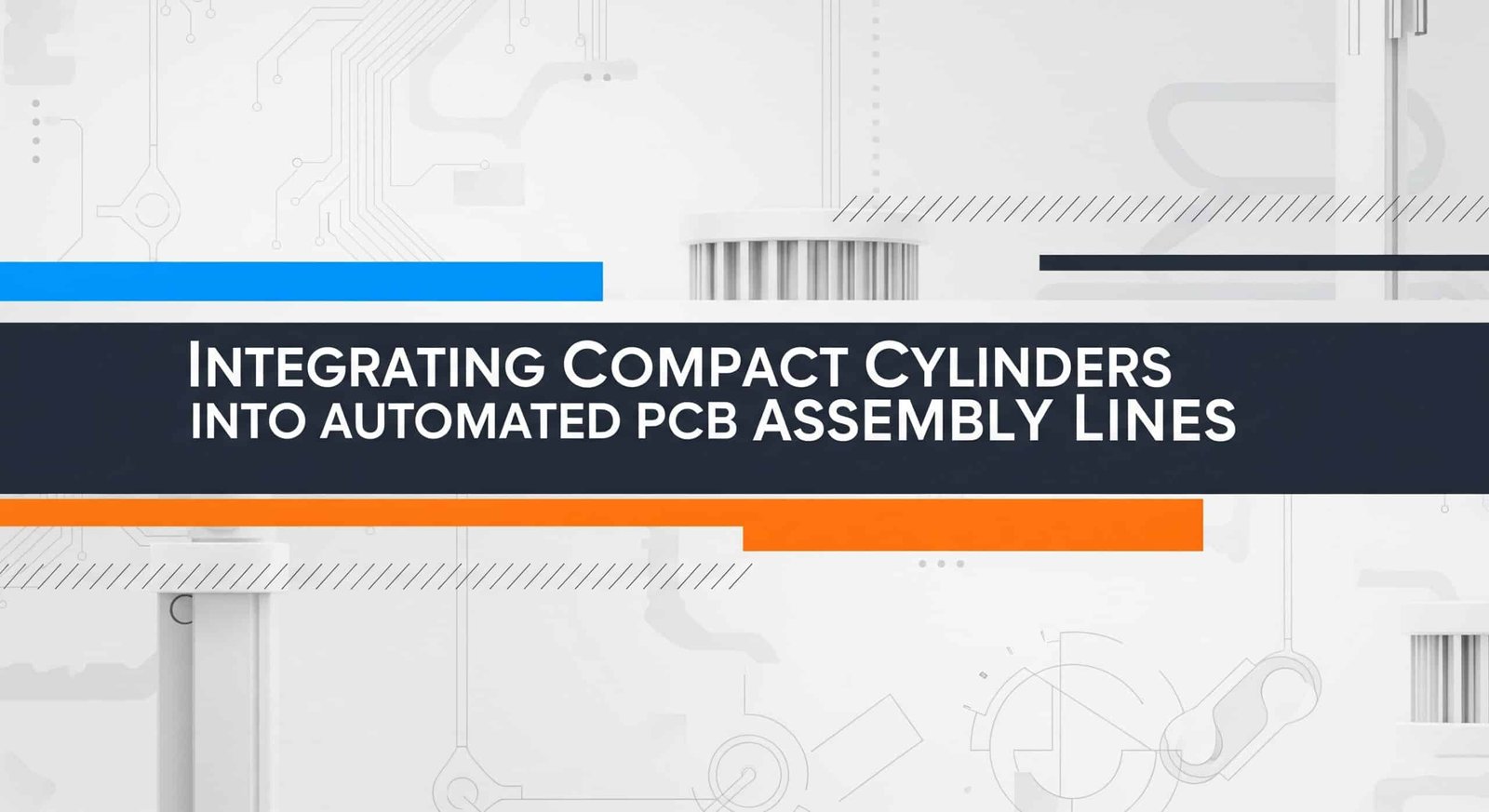Electronics manufacturers struggle with space constraints and precision requirements in automated PCB assembly lines, where traditional pneumatic cylinders create interference issues, consume valuable real estate, and fail to meet the tight tolerances demanded by modern surface-mount technology1. Bulky actuators disrupt workflow optimization while inconsistent positioning leads to defective assemblies and costly rework cycles.
Compact cylinder integration in PCB assembly requires space-efficient rodless designs, precise positioning control within ±0.1mm tolerances, clean room compatibility, vibration-free operation, and modular mounting systems that maximize throughput while maintaining the sterile environment and accuracy essential for high-density electronic component placement.
Just last week, I worked with Michael, an automation engineer at a contract manufacturer in North Carolina, whose pick-and-place machines were experiencing frequent misalignments due to oversized pneumatic actuators. After retrofitting with our compact rodless cylinders, his line achieved 99.7% placement accuracy and increased throughput by 15% through better space utilization. 🔧
Table of Contents
- What Makes PCB Assembly Lines Unique for Pneumatic Integration?
- How Do You Select the Right Compact Cylinder Configuration?
- Which Installation Techniques Optimize Performance and Space?
- What Maintenance Practices Ensure Consistent Assembly Quality?
What Makes PCB Assembly Lines Unique for Pneumatic Integration?
PCB assembly environments demand specialized pneumatic solutions that differ significantly from general manufacturing applications.
PCB assembly lines require pneumatic cylinders with sub-millimeter positioning accuracy, contamination-free operation, electromagnetic compatibility2, minimal vibration transmission, compact footprints under 50mm width, and cycle speeds exceeding 300 operations per minute while maintaining consistent force control for delicate component handling.
Environmental Requirements
Clean Room Standards
PCB assembly environments maintain strict contamination control:
- Class 10,000 clean rooms3 require sealed actuators
- Particle generation must be minimized during operation
- Outgassing materials can contaminate sensitive electronics
- Static discharge protection prevents component damage
Electromagnetic Compatibility (EMC)
Electronic assembly equipment creates unique challenges:
- RF interference from switching power supplies
- Magnetic field sensitivity affects precision positioning
- Grounding requirements for static discharge protection
- Shielded cable routing prevents signal interference
Precision and Speed Demands
Positioning Accuracy Requirements
| Application | Tolerance | Typical Cylinder Type |
|---|---|---|
| Component placement | ±0.05mm | Servo-controlled rodless |
| PCB transport | ±0.1mm | Guided compact cylinder |
| Fixture positioning | ±0.2mm | Standard compact cylinder |
| Cover/shield placement | ±0.5mm | Mini cylinder |
Cycle Time Optimization
Modern assembly lines demand:
- High-speed operation up to 500 cycles/minute
- Acceleration control prevents component damage
- Dwell time precision for adhesive curing
- Synchronized motion with other automation components
Space Constraints
Equipment Density Challenges
- Multi-level assembly requires vertical space efficiency
- Conveyor integration limits mounting options
- Vision system clearance affects actuator placement
- Maintenance access must be preserved
Thermal Management
Heat generation affects precision:
- Component temperature stability requirements
- Thermal expansion compensation in positioning
- Heat dissipation from compact actuators
- Ambient temperature control in assembly areas
How Do You Select the Right Compact Cylinder Configuration?
Proper cylinder selection ensures optimal performance in demanding PCB assembly applications.
Select compact cylinders based on stroke length requirements, force specifications for component handling, mounting configuration compatibility, position feedback options, speed control capabilities, and environmental sealing ratings while ensuring EMC compliance and integration with existing automation controllers.
Technical Specifications
Force and Stroke Requirements
Typical PCB assembly applications:
- Component placement: 5-50N force, 10-100mm stroke
- PCB transport: 20-200N force, 50-500mm stroke
- Fixture actuation: 10-100N force, 5-50mm stroke
- Cover installation: 50-500N force, 10-100mm stroke
Speed and Acceleration Control
- Variable speed control from 10-2000mm/sec
- Acceleration ramping prevents component shock
- Deceleration cushioning ensures gentle positioning
- Programmable profiles for different components
Position Feedback Options
Sensor Integration
- Magnetic reed switches for basic positioning
- Linear potentiometers for analog feedback
- Optical encoders for high-precision control
- Magnetostrictive sensors for absolute positioning
Controller Compatibility
- PLC integration with standard I/O
- Fieldbus communication (Profibus, DeviceNet)
- Ethernet connectivity for Industry 4.04
- Servo drive compatibility for closed-loop control
I recently helped Sarah, a production engineer at an LED manufacturer in Texas, who needed precise component placement for miniaturized circuit boards. Her existing cylinders couldn’t achieve the required ±0.02mm tolerance. We provided custom rodless cylinders with integrated linear encoders that improved her placement accuracy by 300% while reducing cycle time by 20%. 📱
Environmental Considerations
Sealing and Protection
- IP65 rating minimum for electronics environment
- Food-grade seals for medical device assembly
- Chemical resistance to cleaning solvents
- Temperature stability across operating range
Material Selection
- Anodized aluminum bodies resist corrosion
- Stainless steel components for harsh environments
- Non-magnetic materials prevent interference
- Low-outgassing plastics for clean room use
Which Installation Techniques Optimize Performance and Space?
Strategic installation maximizes the benefits of compact cylinders in space-constrained assembly lines.
Optimize compact cylinder installation through modular mounting systems, integrated guide rails, flexible coupling arrangements, coordinated motion programming, proper cable management, and systematic integration with vision systems and quality control equipment to achieve maximum space efficiency and operational reliability.

Mounting Strategies
Space-Efficient Configurations
- Vertical mounting maximizes floor space utilization
- Inverted installation improves accessibility
- Side-mounting integrates with conveyor systems
- Multi-axis arrangements for complex motions
Modular Assembly Techniques
- Standardized mounting plates enable quick changes
- Quick-disconnect fittings reduce maintenance time
- Plug-and-play connectors simplify installation
- Modular guide systems provide precision alignment
Integration with Automation Systems
Motion Control Coordination
- Master/slave programming synchronizes multiple axes
- Electronic camming creates complex motion profiles
- Position interpolation ensures smooth trajectories
- Safety interlocking prevents equipment damage
Vision System Integration
- Coordinated positioning with camera systems
- Calibration procedures maintain accuracy
- Dynamic focusing adjustments during operation
- Quality feedback loops for continuous improvement
Cable Management and Routing
Signal Integrity Protection
- Shielded cables prevent electromagnetic interference
- Proper grounding techniques reduce noise
- Cable separation from power conductors
- Strain relief prevents connection failures
Maintenance Accessibility
- Removable cable trays enable easy access
- Color-coded connections speed troubleshooting
- Documentation labels identify circuit functions
- Test points facilitate diagnostic procedures
Performance Optimization
Calibration Procedures
- Initial setup protocols for new installations
- Periodic recalibration maintains accuracy
- Temperature compensation adjustments
- Wear compensation algorithms extend service life
Monitoring and Diagnostics
- Performance trending identifies degradation
- Predictive maintenance prevents failures
- Alarm systems alert operators to problems
- Data logging supports continuous improvement
What Maintenance Practices Ensure Consistent Assembly Quality?
Proactive maintenance prevents quality issues and extends equipment life in demanding PCB assembly environments.
Maintain consistent assembly quality through scheduled lubrication with electronics-compatible products, regular calibration verification, seal inspection and replacement, contamination monitoring, performance data analysis, and preventive component replacement based on cycle counts and operating conditions.
Preventive Maintenance Schedules
Daily Inspections
- Visual inspection for obvious damage or wear
- Operation verification of critical functions
- Cleanliness assessment of work areas
- Performance monitoring through system diagnostics
Weekly Maintenance
- Lubrication service with clean room compatible products
- Calibration verification using precision gauges
- Seal condition inspection for wear or damage
- Cable inspection for strain or contamination
Monthly Service
- Comprehensive cleaning with approved solvents
- Detailed calibration procedures
- Wear measurement of critical components
- Performance documentation and trending
Contamination Control
Clean Room Protocols
- Proper garments and procedures for maintenance
- Approved cleaning materials and methods
- Contamination monitoring during service
- Documentation of all maintenance activities
Lubrication Management
- Electronics-compatible lubricants only
- Minimal application quantities
- Contamination-free application methods
- Proper disposal of waste materials
Performance Monitoring
Quality Metrics Tracking
- Placement accuracy measurements
- Cycle time consistency monitoring
- Reject rate correlation with maintenance
- Overall equipment effectiveness5 (OEE) calculation
Predictive Maintenance Indicators
- Force variation trends indicate wear
- Speed degradation suggests lubrication needs
- Position drift indicates calibration requirements
- Vibration analysis detects bearing wear
Troubleshooting Common Issues
Accuracy Problems
- Mechanical wear in guide systems
- Thermal expansion effects on positioning
- Contamination affecting sensor operation
- Calibration drift over time
Speed and Performance Issues
- Lubrication degradation reduces efficiency
- Air supply pressure variations
- Control system parameter drift
- Mechanical binding from contamination
At Bepto, we understand the critical nature of PCB assembly operations and provide specialized compact cylinders designed specifically for electronics manufacturing. Our technical support team works closely with automation engineers to ensure optimal integration and long-term reliability in these demanding applications. 🎯
Conclusion
Successful compact cylinder integration in PCB assembly lines requires careful attention to precision requirements, space constraints, environmental conditions, and maintenance protocols that ensure consistent quality and maximum equipment uptime in demanding electronics manufacturing environments.
FAQs About Compact Cylinders in PCB Assembly
Q: What positioning accuracy can I expect from compact cylinders in PCB applications?
High-quality compact cylinders with integrated feedback systems can achieve positioning accuracy of ±0.05mm or better, with repeatability typically within ±0.02mm when properly calibrated and maintained in controlled environments.
Q: How do I prevent electromagnetic interference between cylinders and sensitive electronics?
Use properly shielded cables, maintain adequate grounding, select cylinders with EMC-compliant components, route pneumatic and electrical lines separately, and follow manufacturer guidelines for installation in electronic environments.
Q: What’s the typical service life of compact cylinders in high-speed assembly applications?
Well-maintained compact cylinders in PCB assembly typically achieve 10-50 million cycles depending on operating conditions, with proper lubrication and contamination control being critical factors in achieving maximum service life.
Q: Can compact cylinders operate reliably in clean room environments?
Yes, properly sealed compact cylinders with appropriate materials and clean room compatible lubricants can operate reliably in Class 10,000 environments and cleaner, provided proper maintenance protocols are followed.
Q: How do I integrate compact cylinders with existing PLC control systems?
Most compact cylinders offer standard I/O interfaces compatible with common PLCs, with options for fieldbus communication, analog positioning control, and servo integration depending on your specific automation requirements and precision needs.
-
Learn the fundamentals of SMT, the primary method for producing modern electronic circuits. ↩
-
Understand the principles of EMC and why it’s crucial for preventing interference in electronic systems. ↩
-
Explore the international standard for cleanroom classifications and air cleanliness. ↩
-
Discover the core concepts of the fourth industrial revolution and its impact on automated manufacturing. ↩
-
Learn the methodology behind OEE, a critical key performance indicator for measuring manufacturing productivity. ↩




